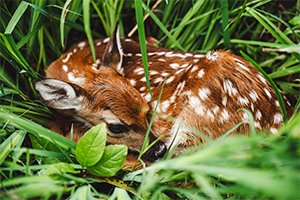White-tailed Deer in New Hampshire
Important Information on White-tailed Deer in New Hampshire
 Fawns
Fawns
If you see a fawn, or any young wildlife, and suspect it has been abandoned, DON'T pick it up. Its best chance for survival is probably in the wild. May and June are the time of year when deer fawns are born in New Hampshire. Each year, people in the state are lucky enough to view and photograph these beautiful young animals…and that is where these fortunate encounters should end.
People often see young fawns alone that seem weak and motionless, and fear the worst. Has the mother died? Has she abandoned her fawn? In most cases, the doe is not far off, waiting to return to feed her newborn fawn.
Not Abandoned
Seeing a fawn (or a moose calf) alone does NOT mean it has been abandoned. It is normal for a doe to leave her fawn alone for several hours at a time while she is off feeding. She may not return until nightfall to nurse her fawn. This actually helps keep the fawn safe from predators.
Fawns (only 4-10 lbs. at birth) are born with little scent and a spotted camouflage coat. They are not very mobile, though. They will bed down in high grass or thick vegetation and remain motionless, trying to avoid detection from predators.
 The doe, on the other hand, can be easily detected by predators due to her scent and large size, so she spends time away from her fawns to help keep them hidden. Does may only visit their fawns 3-4 times a day to quickly nurse before leaving again for hours, although usually not straying too far.
The doe, on the other hand, can be easily detected by predators due to her scent and large size, so she spends time away from her fawns to help keep them hidden. Does may only visit their fawns 3-4 times a day to quickly nurse before leaving again for hours, although usually not straying too far.
Fawns mature quickly and are not helpless for long. After about a month, they can elude most predators. By 2-3 months, they are able to survive without milk although they may continue nursing into the fall.
Contact Fish and Game
The best chance a young wild animal has to survive is in its natural environment under the care of its mother. If you see a fawn (or any other young wildlife) and suspect it has been abandoned or orphaned contact NH Fish and Game by emailing wildlife@wildlife.nh.gov or calling (603) 271-2461 and make a report. Fish and Game staff can assess the situation and help determine the best course of action.
Quick Links
Avoid Deer / Vehicle Collisions
Motorists are advised to watch for deer crossing roadways throughout the year, but especially in the late fall at dawn and dusk. Deer are very active at that time of year because the mating season, or rut, is underway and bucks and does have their minds on other things than traffic!
To reduce the chance of hitting a deer on the road:
- Be especially cautious when driving at dawn and dusk, when deer are most active.
- Remember, deer are creatures of habit. If you have seen deer crossing the road in a certain location, slow down and use caution when driving in that area.
- If you see one deer on the road, keep a sharp eye out for others. If you see a doe, stay alert - her fawns or a rutting buck may be following close behind.
Many Deer Collisions Occur in the Fall
In a typical year, an estimated 1,200 deer/vehicle collisions occur in New Hampshire. Almost a third of all deer-vehicle collisions in New Hampshire occur from mid-October through the end of November.



